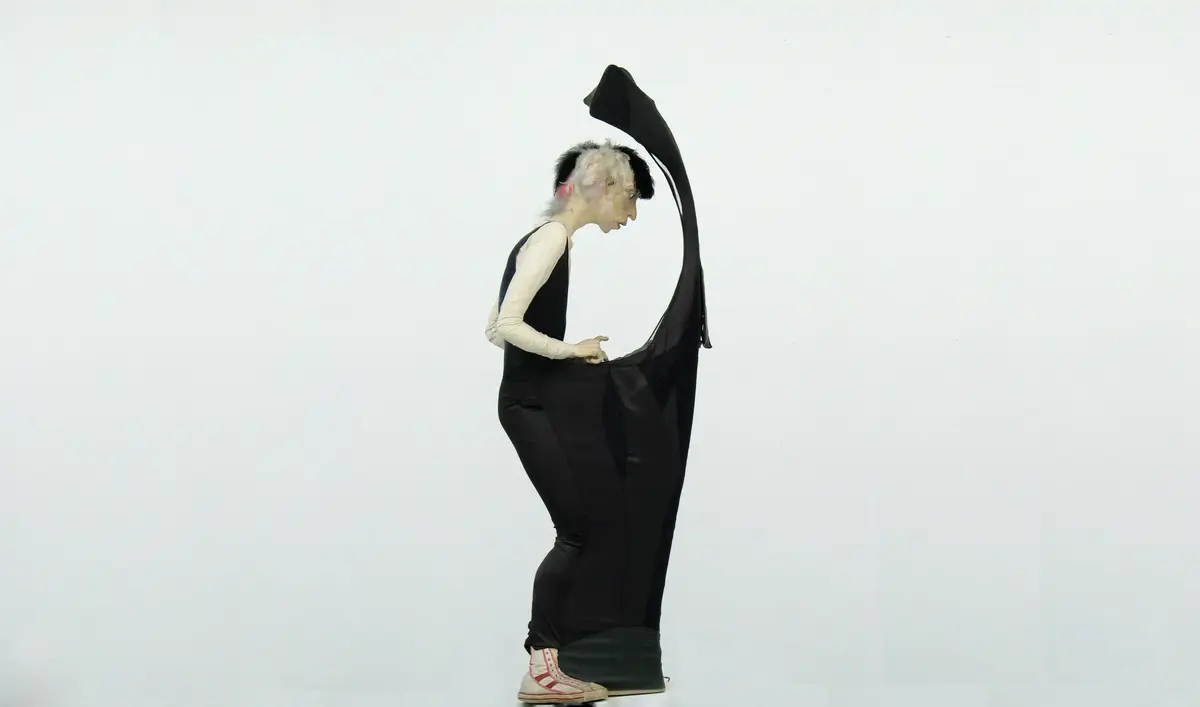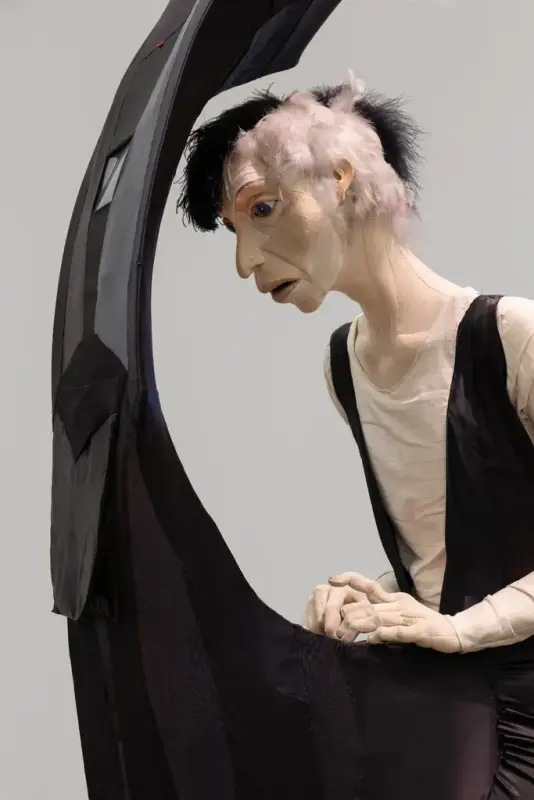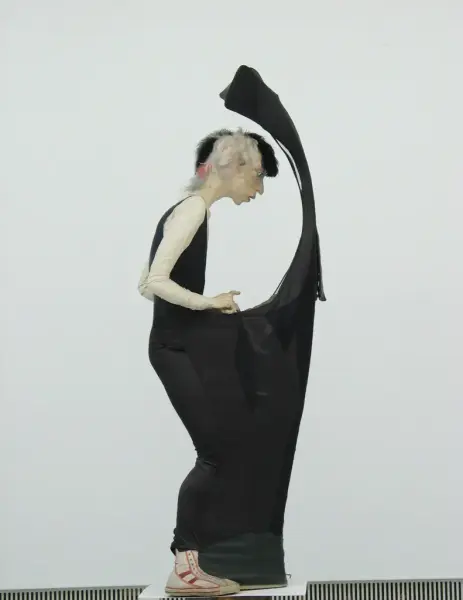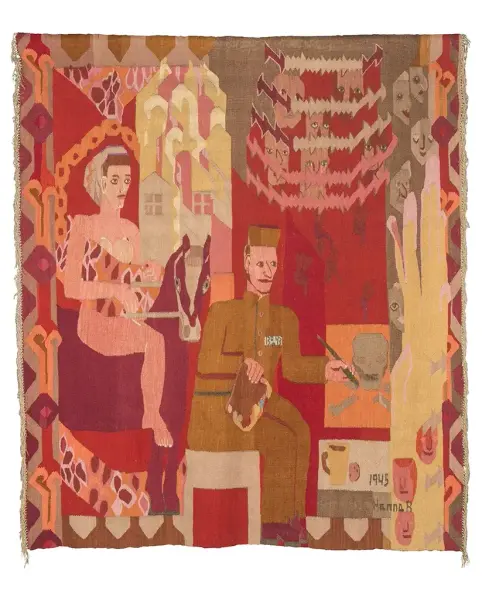Podcast
Listen to Maritea Dæhlin speak about her mother, artist Gitte Dæhlin's artistic practice and the work featured in the exhibition Passing Motherhood.
Language: English
- 1/1
Duration: 5 min 7 sec
Tatt av spillet (Taken by the Game), 1980
textile sculpture with a light component
189 cm
From the collection of the Trondheim Kunstmuseum
Gitte Dæhlin (1956–2012) began her artistic education in ceramics as an apprentice working with her mother. However, she chose early on to distance herself from this tradition and developed a distinctive textile and leather-based technique, in which she tightly sewed fabric around sculptural forms. It is through this technique that the sculpture Taken by the Game was made. It was originally shown at her debut exhibition at Galleri Dobloug in 1981 and was acquired by Trondhjems Kunstforening the same year. Not shown for decades, the status of an artwork hibernating in museum storage opens up questions about passing down the late artist’s legacy, stretched, as it was, between family members, institutional responsibilities, and social agenda.
The working method came at a price. When Gitte had her daughter Maritea in 1986, she realized that her hands had become rough and hard after years of intense stitching. In order to regain soft hands to touch her child, she had to find a new way of working. Turning to papier-mâché marked a new departure in her practice: it is a material of low status that gave her a tactile and immediate working process and, most importantly, a mother’s hands. This story, which Maritea Dæhlin draws on in a new sound work for the exhibition, shows how freely motherhood circulates between bodily and artistic choices.
Dæhlin’s artistic practice was often moved by political and feminist questions, particularly those concerning gender roles, identity, and power structures. Moving to Mexico in 1977, and living there most of her life, she worked at the intersection of sculpture, craftsmanship and issues around solidarity. She lived in San Cristóbal de las Casas, and the indigenous cultures movement there, in southeastern Mexico, and in Guatemala, with which she had a close relationship, had a profound influence on her work.[1] Later on, she was closely engaged in solidarity work with the Zapatista movement.[2]
Taken by the Game, however, differs from her more explicitly political works. Instead, it explores a phenomenon that was in its infancy in the 1980s but has since grown into a massive cultural and economic market: video games. Gaming addiction and digital escapism are now the subject of extensive debate but, as early as the 1980s, concerns were expressed about screen use, particularly among young people. The character in Taken by the Game is completely immersed in the game — a state that can be interpreted both as pleasure and as a form of self-destruction. Is she in control of the game, or is she taken by the game? Dæhlin often worked with hybrid beings: female figures fused with animal or mythological beings. In Taken by the Game, the figure is seemingly without such transformative features. Yet it has an intense presence, a silent commentary on how technology and identity intertwine. Today, at a time when digital worlds dominate both social and economic interaction, the work seems prophetic.
In the context of this exhibition, in which motherhood is explored as a dynamic and changeable concept, Taken by the Game, not originally created with motherhood in mind, allows for a new reading. If a viewer sees this figure as a mother, she emerges as an unconventional one — one who is not defined solely by her caring role, but who maintains her own agenda and identity. What does it mean to be a mother who is not primarily defined by caring?
This question gains further depth in light of the material heritage that characterises the exhibition. Taken by the Game is shown alongside works by both Gitte Dæhlin's daughter, Maritea Dæhlin, and her mother, ceramicist Lisbet Dæhlin. Maritea Dæhlin has curated a space where this matrilineal connection is central, creating an artistic dialogue across generations.
Later in life, Gitte Dæhlin returned to clay, the material she had once abandoned. For the large public work, Flokk (2011), a permanent outdoor installation made of 21 bronze figures, she proceeded via ceramic modelling to bronze casting and, in a way, she came full circle back to her original starting point. Taken by the Game can thus be seen in the light of a lifelong material investigation, a continuous negotiation between body, craft and life experiences.
- Marianne Zamecznik
[1] San Cristóbal de las Casas — often referred to simply as San Cristóbal — is located in the state of Chiapas in south-eastern Mexico. The city lies in the highlands and is surrounded by large indigenous communities, particularly Mayan ethnic groups such as Tzotzil and Tzeltal. Inequality and a lack of political representation led to the emergence of various indigenous and peasant movements in the 1980s. As early as the 1970s San Cristóbal became a focal point for researchers, artists, anthropologists and activists from all over the world who were concerned with indigenous culture and human rights.
[2] One of the most famous political mobilisation in the region surfaced in 1994 when the Zapatista movement, Ejército Zapatista de Liberación Nacional (EZLN), rebelled. The background to this was decades of dissatisfaction with land distribution, human rights and indigenous autonomy.
- 1/1
Gitte Dæhlin, Tatt av spillet (Taken by the Game). Courtesy Trondheim kunstmuseum. Photo: Dag Asle Langø
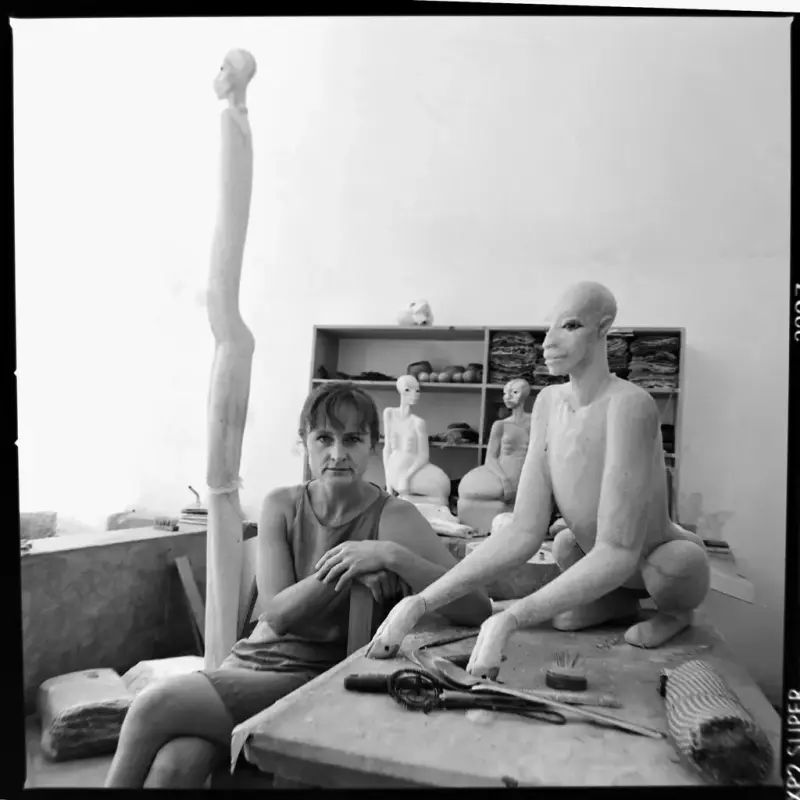
Gitte Dæhlin in her studio
Photo: Marcela Taboada
Gitte Dæhlin (she/her, b.1956, Oslo – 2012, Oslo) was a Norwegian sculptor, textile artist and draughtswoman. The daughter of ceramicist Lisbet Dæhlin and art historian and critic Erik Dæhlin, she is known for her expressive and thought-provoking human-like figures in textiles made of canvas or silk tightly sewn over a fixed form. She studied at Bournemouth & Poole College of Art in England. Dæhlin was among the first students to attend Vestlandets Kunstakademi (Western Norway Art Academy) from 1974–7, studying under Bård Breivik and Morten Krogh, whose work on solidarity was influential for her early development. In 1975, she co-curated Norway's first feminist exhibition Kvinner — kunst — kamp (Women — Art — Struggle) in Bergen, along with Helga Norland, Therese Christensen and Elisabeth Haarr. Her first solo exhibition of textile sculptures took place in 1980 at Galleri Dobloug, Oslo. In the autumn of the same year, she participated in the Youth Biennale in Paris. In 1977, Gitte moved to Chiapas, Mexico, on the border with Guatemala, where she spent over two decades working closely with the local community on agricultural, land and indigenous rights, before moving to Oaxaca. Her biggest exhibition in Norway was UrRo at the Lillehammer Art Museum in 2010. In 2011, Dæhlin finished her last art project, Flokk, a permanent outdoor installation made up of 21 bronze figures placed in the landscape at Sygard Grytting in Sør-Fron kommune. Dæhlin died on 2 December 2012, aged just 56.
Production credits
Gitte Dæhlin, Tatt av spillet (Taken by the Game), textile sculpture with a light component, 189 cm, 1980
From the collection of the Trondheim Kunstmuseum
Conservator: Peter Juga
